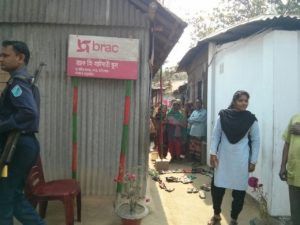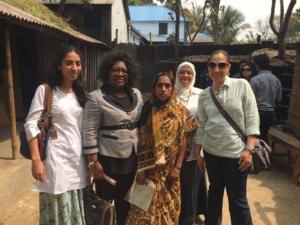I still vividly remember the summer eight years ago when Sameer was interning at Ujjivan. He quickly saw that providing financial services to those at the base of the pyramid was not a regular business. It was sometimes a matter of life or death to the end customer whether they received their money on time or not. It shook him up and inspired the need for innovation in him. It was from this combination of compassion and creativity that the idea of Artoo emerged. What I remember most clearly from that summer, of course, are all the stories that he brought back from the field about the vibrant, resilient, creative, and inspiring working poor women whom he met. I don’t think he knew yet that improving their lives through impactful technology interventions was something he’d pursue with such fierce commitment, but I did.
I’ve been lucky to go along on the adventure — literally, in the early years when I was involved in shaping Artoo, and of late figuratively, as I’ve stepped out to begin teaching. However, a big piece of my heart will always belong to Artoo, and my favourite part of will always remain the stories from the field. So, I was delighted to accompany Sameer on a visit to BRAC in Dhaka last month and to be invited on some incredibly inspiring field visits to understand their diverse and strategic poverty alleviation interventions in Bangladesh and around the world.
As a teacher, the first thing that caught my eye when we visited a pre-primary school run by BRAC was how carefully the children had arranged their chappals in a circle outside their classroom. This BRAC school, a few hours away from Dhaka, like many others is a simple structure: a single room made with tin walls and roofing and anchored by one main teacher and another assistant teacher that is designed to prepare young children for primary school. BRAC’s non-formal primary schools aim to give a second chance at learning to disadvantaged children. These children are left out of the formal education system owing to extreme poverty, violence, displacement, or discrimination.
Inside, it was deeply moving to see a flourishing classroom functioning beautifully with simple but thoughtful educational materials provided by BRAC. The teachers and students were using innovative methods of teaching and learning; for example, the children had a train song, where at every station the children stopped and checked if their clothes were clean, their hair was neatly combed, their nails clipped — a great way to teach children about personal hygiene.
We then visited two beneficiaries of the BRAC ‘Targeting the Ultra Poor’ programme. Through this programme, BRAC strives to improve the lives of people who suffer from chronic hunger, often do not have adequate shelter, are susceptible to many types of diseases, deprived of education and are particularly vulnerable to the effects of natural disasters.
We met Shireen, a graduate of the TUP programme. In 2010, Shireen had no source of livelihood; so, BRAC gave her 1 cow, 10 chickens, a stipend and access to TUP’s support system. By 2012, she graduated from TUP and became a BRAC microfinance customer. She now has 3 cows, 15 chickens, a goat, a motorcycle, and a source of livelihood. We also visited Asiya, a current member of the TUP programme who has already made great progress so far. With help from BRAC, Asiya’s family is working with livestock to create a sustainable livelihood for themselves. However, perhaps even more importantly, they now have access to potable water and have been able to install a latrine near their home.
After this, we visited the Ayesha Abed foundation and the Aarong store, which empower women to preserve local handicraft traditions by providing them access to fair trade and helping them earn a sustainable livelihood (as well as access to other essential services — health, financial, legal). You can read more at http://www.aarong.com/about-aarong.
From block printing to intricate hand embroidery on textiles, it was sheer joy to watch the women create masterpieces out of wooden blocks and fine threads from needles. The foundation had a library of block print patterns, neatly arranged in rows of wooden boxes. From Batik prints on Sarees to hand painting and screen printing, the myriad display of colors through artwork was breathtaking. It was truly heartening to see how the foundation’s initiatives have helped women earn their livelihood while nourishing their artistic talents.
I came away from BRAC deeply moved and inspired by their work because you can see without a doubt that this is a movement that will leave no stone unturned on the path to alleviating poverty. Once you’ve set your heart upon doing something as worthwhile as improving the lived realities of those who are most marginalized, I suppose it’s imperative that you dream big, innovate often, and take meaningful leaps of faith that spin you in unexpected but impactful directions. Sameer and I both came back from Dhaka with our eyes full of possibilities and our hearts warmed by all the inspiration Artoo could draw from BRAC.


